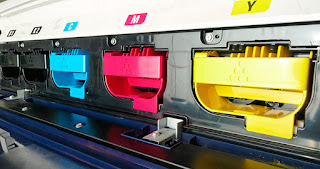5 Things You Need to Know to Prepare Your Designs for Print
One of the greatest things about being a printer is seeing all of the amazing designs created by graphic designers and artists. It's fun to see someone's creativity and ideas become a tangible and beautiful piece of printed art.However, we run into a few common problems when receiving artwork from designers. These five steps will help you prepare your design files to prevent lost time and money.
1. Include bleeds and remember to keep content inside the safe zone. Since most printed items will be cut to a specific size, we need the colors and background images to extend a small amount past the actual final trimmed size. That way you won't end up with a white border around the edge of your design.
When you set up your document in Illustrator, InDesign, or other programs, make sure you add a bleed to your file. The standard bleed for most printed material is 1/8" (0.125) on each side. Forgetting to add bleed is one of the main reasons we send files back to the designer for fixing before we can print. For more information on setting up your design with bleed and safe zones, visit our designer resource page.
2. Make sure your artwork is created in CMYK format. It's easy to forget that printers use the CMYK color profile when many images and online designs are created in RGB. Unfortunately, RGB doesn't convert perfectly to CMYK, so your best option is to set up your document in CMYK and make sure any images you add are converted from RGB to CMYK so that you can make any necessary color adjustments in your design. Visit our color profiles page for more information.
3. All designs and images should be created at print resolution, which is 300 dpi. Often designs for the web are created at 72 dpi, but this will look blurry when printed. For the sharpest images, make sure all your photos are 300 dpi. Also, your design should be created at the same size and dimension as your final printed product (plus bleeds). So, if you are creating a flyer which will be 8.5 x 11 inches, create your design file at 8.5 x 11 inches plus a bleed of .125 on each side at a resolution of 300 dpi.
4. Outline your fonts before saving as a pdf. For specific instructions on how to do this, check out our previous blog post on outlining fonts. Another option is to include your font file with your design file, but we prefer to have the fonts outlined. This converts the fonts into simple vector layers which means that they won't change appearance when we open them on our computer. Once your artwork is completed, you should save or export your design as a print quality pdf (and be sure to include bleed and trim marks).
5. Before sending your final design to the printer, print out your design and have someone else proofread it. For some reason, mistakes are more apparent once they have been printed. We recommend that you print your design on your home or office printer. Even if it's smaller than the actual design, you will quickly notice things that aren't obvious on a computer monitor.
Check to make sure your spelling and contact information is correct, but also make sure all important information is included. Did you include the date and location of your event on your postcard design? Do you have an expiration date on your coupon design? Is there a website or phone number on your ad so people can get in touch with you? Is the author listed on the book cover?
A surprising number of people forget these items and although we try to do our best to catch these errors, we don't always know the information needed and that leads to delays in printing and sometimes costly reprints.
If you want more information on setting up your design files for print, please visit our new designer resource pages. You'll find detailed instructions on preparing your artwork for your printer. We look forward to seeing your next design and assisting you in making your masterpiece into reality.
To schedule a tour of our facilities, please contact us. We would be happy to show you the process of printing. We are proud of our craftsmanship and artistry.







